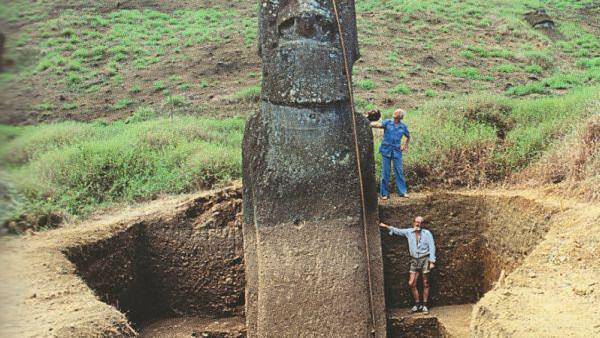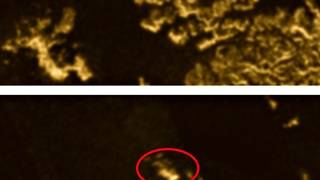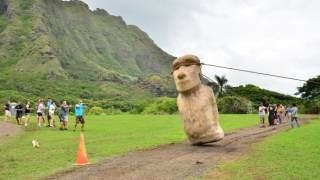Mystery of the Easter Island Statues
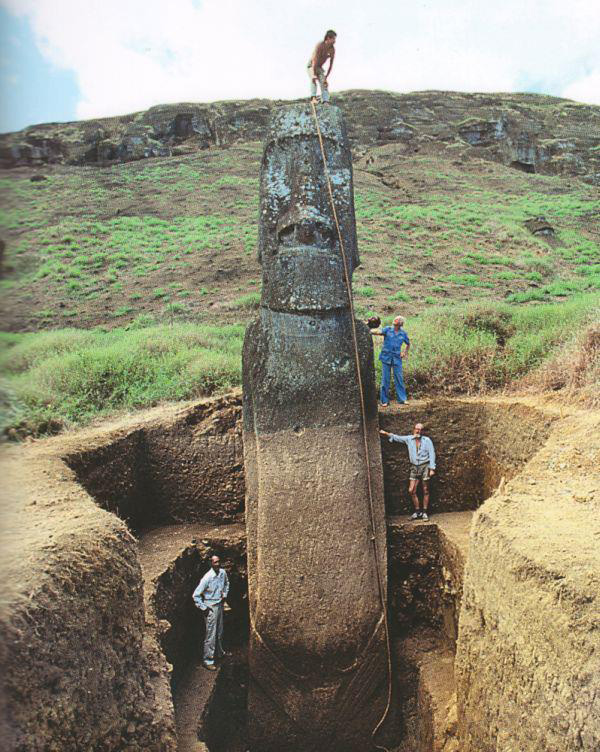
Easter Island Statue with full body excavated.
Almost everyone has seen the iconic images of the Easter Island statues staring silently out from the hillsides. For years I thought these were the only Moai on the island. I knew nothing of the statues erected on ahu or the fallen moai at the other sites. Seeing these pictures many people have come to believe that all Moai faced the ocean while it is the exact opposite that is true. With the exception of Ahu Akivi all erected Moai face inland. It is believed they were positioned that way to watch over the villages. At Rano Raraku the statues face away from the crater.
The fact is these statues were not meant to have stayed in this place. The Moai that you see half buried on the sides of the volcanic cone of Rano Raraku were pieces waiting to be transported to ahu around the island. The Moai that you see sticking up out of the ground have bodies that extend down underground 20 - 40 feet, all the way to the waist. Centuries of erosion from the slopes above have covered all but the tops of these giants - the largest Moai ever constructed. One of the unfinished moai, completely carved but not removed from the crater wall, is a staggering 70 feet in length. Many doubt this statue could ever have been raised successfully. Giving their ingenuity and obsession, I believe they would have eventually.The slopes of Rano Raraku are filled with eye-less moai - several hundred circle the crater in various stages of construction.
Many have a more detailed and finished look than the moai erected on the island’s ahu. There are some that disagree that these statues were finished pieces waiting for transport and believe that they were never meant to be move from the slopes surrounding their birth place. Perhaps it was a "Moai Showroom" of sorts where local leaders could come and pick out their favorite design!
Thor Heyerdahl’s team was given one day in 1987 to excavate and measure the full length of the moai. Its regal head tapers into a long thin body with carved tattoo and loin cloth relief’s on its surface. It has a distinctly phallic shape to it and some have proposed that all the moai were purposely designed around a phallus shaped form.
The interior of the caldera contains many finished and unfinished moai as well. Erosion has covered many nearly completely and it’s possible more lay beneath the ground, covered by hundreds of years of erosion. The potmarked walls from which the moai where carved can clearly be seen in this photo taken of the interior of the Rano Raraku caldera just above the crater lake.
Excerpt from: mysteriousplaces.com
The stone heads of Easter Island
By Philip Coppens
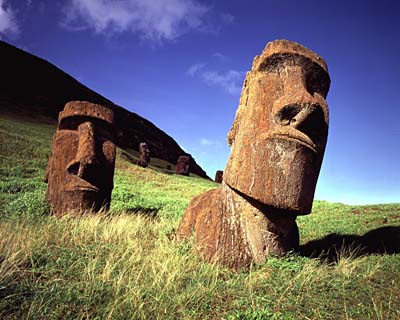 The stone heads of Easter Island have cast an almost magical spell on anyone that has seen them – if only in a photograph. Though often eyeless, they still gaze along the shores of the island. What were they built for and who were the artisans of these mysterious creations?
The stone heads of Easter Island have cast an almost magical spell on anyone that has seen them – if only in a photograph. Though often eyeless, they still gaze along the shores of the island. What were they built for and who were the artisans of these mysterious creations?It was Easter 1722. The Dutch Admiral Jacobs Roggeveen had discovered a new island in the Pacific Ocean. He named it Easter Island. Near the coastline, his crew saw small boats of the local people setting off to greet his ship. Scanning the coastline of the island, he saw gigantic heads.
Roggeveen gave this description of the heads: “the stone heads surprised us. We could not understand how these people, who do not have load-bearing wood to make machinery, or strong rope, succeeded in erecting these statues, statues that measure ten metres in height and width.” Roggeveen had just added one more entry in the growing list of mysteries: the more Westerners travelled the globe, the more enigmas they came across.
When Roggeveen arrived, there were two tribes on the island. The first was the Ha-nau-aa-epe, which was distinct because of their long ears. They were tall, white-skinned with red hair and ca. two metres tall. The other tribe was the Ha-nau-mo-moko, which had short ears. Though it is assumed that the statues were created by the short-eared tribe, under the command of the long-eared people, portraying the latter, there was also a massacre of the long-eared people in 1760; apparently only three of them survived. The massacre is normally interpreted as a revolt of the short-eared people against their oppressive elite of the long ears.
The type of “diplomacy” used when liaising with the local people often meant that no further knowledge about the stone heads was easily recorded. Roggeveen himself felt he had found a quick answer to “his” mystery. He chopped off the head of one statue, in the supposition that the heads were not really made of stone, but of clay, covered with a coating of seashells. His theory proved incorrect.
It lasted until 1770 before the Spanish decided to send an expedition in search of this island that had been left to its own devices for the past five decades. The expedition proved that the heads were definitely made of stone.
The local population had to contend with great tribulations between 1770 and 1774, by which many statues had also fallen from their bases. James Cook identified that the only hill on the island was actually a volcano and identified it as the main cause for the destruction that had occurred by 1774. Cook also concluded that the current inhabitants of the island were not the creators of the heads.
But who was then? Two hundred years later, the Swiss controversial author Erich von Däniken speculated that the statues were the work of extraterrestrial beings. These beings were believed to have been stranded on the island and with nothing better to do, they had begun to erect these statues. Von Däniken argued that the local population, with the primitive tools they had at their disposal, were unable to create the heads.
His was just one opinion amongst several. Others believed that the statues were millennia old, the last remnants of a lost civilisation, Mu, the Pacific Ocean colleague of Atlantis. There were, however, more conservative views. Cook and other expedition leaders concluded that the platforms on which the heads stood were used for funerals. The statues were also named after former rulers of the local people. But no further information was learned from the local people, if only because those were exported from the island as slave labour. Indeed, by 1877, only 111 people were still living on the island.
The civilisation of Easter Island was eventually made famous by the British pioneering expedition of Katherine Routledge, who arrived on the island in 1914 and began what amounted to the first serious archaeological campaign into the mysteries of the island and – specifically – its enigmatic stone heads. With help from the locals, she and her husband eventually excavated thirty figures and recorded the island’s legends and history.
A century onwards, the origin of almost thousand stone heads remains nevertheless extremely difficult to assess. All statues gaze towards the land, even though many of the statues stand very close towards the sea. They measure between two and eleven metres high and all have the same appearance: a long shaped head with an upper torso, a chin and long ears, with arms along the body or arms that rest on the stomach. Some statues still contain eyes, made in white and red stone and coral. Only ca. seventy of the more than thousand statues have a “pukao”, or “hats”, on their head. The name originated from reports of the first visitors, who had spotted certain local people with a headdress made of red feathers. This small number of hatted heads has puzzled archaeologists for many decades. The volcanic rock used for the hats came from a sacred quarry inside a crater full of red scoria, a volcanic pumice. The rock had to be transported for several miles on rolling tree trunks. Sue Hamilton believes that the hats were, in fact, a plait or top knot that was only worn by the elite chieftains.
The 20th century did provide an answer to their age. Archaeologists learned that the first people had come to the island between the 4th and 7th century AD. The platforms were constructed shortly afterwards, with the statues beginning to be erected after 1000 AD. No more statues were erected after 1680, the result of society collapsing, caused by or resulting in warfare. Conclusion: the statues were constructed over a 500 year period – meaning that on average, two heads were erected each year.
The stone used for the heads originated from the inner core of the Rano Rarku volcano. Indeed, there, hundreds of empty spaces remain, though close to 400 statues also still remain inside the quarry. This is an interesting situation, for it would mean that there were enough statues being quarried for a century to come… somewhat unlikely and suggesting more than two statues were erected each year.
One unfinished statue is labelled “El Gigante”. It measures twenty metres tall and weighs 270 ton. Even though the outer layer of the quarry is very hard, the interior stone is hardly more durable than chalk and thus easily modifiable. It is this difference in stone that probably lead to Roggeveen’s erroneous conclusion.
How were the stones quarried? Several pointed stones were still in situ in the quarry; they seemed to be the likely tools that had been used. The Norwegian explorer Thor Heyerdahl tried to recreate the stone heads in situ. Six men worked for three days, resulting in a stone head that was five metres high. It was argued that it would take a team of six people one year to create a giant statue – meaning that the entire production of the stones could be the result of just twelve people – far from the conclusions reached by the likes of Erich von Däniken.
Several traces of tracks from the quarry to the various locations of the statues remain visible, some of them ten kilometres long. What is equally clear is that the largest statues stand closest to the quarry. Though it was no doubt because more effort was required in moving them, at the same time, the statues were quite fragile and might not have survived the longer journeys.
As to how the heads were transported: wooden rollers. The first researchers believed that the island had always been without trees, but more recent research has shown that trees were indeed present on the island. Several possible techniques have thus been recreated in an attempt to see how the statues could be moved. Using wooden carriers, the heads were moved over a distance of fifty metres in two minutes. Later efforts actually involved putting the statues on their back, rather than moving them erect.
As to where the artisans came from, that question was also posed by Thor Heyerdahl. He doubted the general assumption that they had come from the west and felt they originated from Southern America – specifically Peru. However, archaeologists could not support this theory, as they stated that the Peruvian people did not possess sea-worthy craft that would reach as far as Easter Island.
In his unique style, Heyerdahl wanted to challenge this argument and in 1947 organised the Kon Tiki expedition, in which he used a traditional Southern American boat in his effort to reach Easter Island. Heyerdahl’s voyage lasted 101 days, covering 6000 miles, showing that the ship was definitely seaworthy – contrary to the archaeological opinion.
Nevertheless, Heyerdahl did not make it to Easter Island, but ended up in Tahiti. Equally, Heyerdahl was subjected to some critique, as the design used post-dated the Spanish conquest of Southern America. Furthermore, the ship had a sail and was dragged 100 kilometres from the shore before it was allowed to sail on its own power. This was necessary as the strong currents hitting the Peruvian shores did not allow the ship to leave the coastal waters. The currents pushed the ships northwards, towards Panama – not westwards, towards Easter Island.
Heyerdahl’s expedition was the first of a series, all intent to reach Easter Island from Southern America. But all of them ended up in Tahiti – not one ever made it to Easter Island.
Nevertheless, it is true that a certain amount of plants on Easter Island have a Southern American origin. It was in fact such evidence that inspired Heyerdahl and others to argue for the Southern American origins theory. However, subsequently, it has been shown that at least one of these plants was taken to the island more than 30,000 years ago – by animals. Another plant had been spread across the islands of the Pacific Ocean via it drifting on the oceanic currents.
The only proof left to Heyerdahl for a human agent was the presence of the potato on the island. Though it is enigmatic, there is alas no proof that it was transported by humans. It might have been transported by clinging on to birds. One anomaly is just that: an anomaly, not proof positive that the opposite therefore has to be true. As a result, it was clear that the likelihood that Southern Americans had reached Easter Island became less and less likely.
Evidence that the population of Easter Island did actually originate from Polynesia was discovered on the island of Pitcairn, 2000 km west of Easter Island. 1790 traces of a Polynesian influence were discovered there – but the most important discovery was the presence of giant heads, erected on platforms, suggesting a link between Pitcairn and Easter Islands. Unfortunately, the earliest colonists had destroyed these heads, which is one of the primary reasons why this link is little known.
Indeed, when Heyerdahl proposed his alternative approach, little was known about Polynesia as a whole. Heyerdahl lived under the assumption that no technological awareness had ever existed on those islands. Fifty years later, that situation is vastly different. David Hatcher Childress is one of a growing number of authors that has identified that major monuments exist on Polynesian islands. These construction projects are on par to the stone heads of Easter Island – though far less known.
The final breakthrough that the people from Easter Island came from the West and not Southern America came when DNA research of skeletons, dated from 1100 to 1868, revealed similarities with Hawaii and the Chatham Islands, near New Zealand. Indeed, in the end, Heyerdahl himself toned down the Southern American origin theory.
Still, many mysteries of Easter Island remain, like the enigmatic writing known as rongo rongo. At the time of the arrival of the Europeans, there was still a vast store of rongo rongo tablets and other wooden artefacts covered with these hieroglyphs. They were kept in covers made of reed, although few if any could still read them. The language was first seen by a priest, Joseph Eyraud, the first non-local person to settle on the island… and the one to lit bonfires, so that all writings of the Easter Island population disappeared.
Today, only 26 artefacts featuring rongo rongo remain, giving us a total of 16,000 signs. Unfortunately, all attempts to decipher the language have so far seem to failed, though there have been some close calls. In 1886, the American sailor William Thomson discovered two tablets and spoke to an 83-year old inhabitant, who stated that he could read the language, but that he would not: the Church had forbidden the active use of the language. After a bribe, the elder person was willing to look at the tablets, even though he was unwilling to touch them. After having read them, the man, accompanied by a few other locals, sang a fertility song. But because there was no confirmation possible that this was indeed the contents of this text, Thomson’s statements were received with the customary level of scepticism.
However, Professor Benon Z. Szalek of the University of Szezecin is seen by some as the decoder of the rongo rongo language and argues a similar case, namely that “the Easter Island writings constitute sequences of short ritual formulas praising the avatar – incarnation or son of the god. These texts do not contain any genealogies, historical traditions or tales.” Ritual formulas like fertility songs?
Additionally, Szalek believes that it were the Tamils from India that brought their civilisation to Easter Island. “The anthropological studies of the old skulls from megalithic graves indicate an amazing fact, namely that around 60 percent of Easter Island’s population was of Europoidal origin.”
Legends from the island state that the first king, Hotu Matua, brought with him 67 previous tablets from his land of origins in the west and that he also imported the religion of the “bird man” and Make Make. This cult featured an annual race for the first egg laid on the nearby islands of Motu Iti and Motu Nui. The race selected a man, who for the next year became the god Make Make’s personification, and bearer of the divine force that was associated with Make Make. Throughout the year, the man was kept isolated from his family, sealed off in a cave, which would mean that the lack of sunlight made his skin whiter, and hence, they argued, more god-like.
It is clear that the mystery of Easter Island has lost some of its enigmatic fringes in recent years. Nevertheless, the final word has not been spoken about the meaning of the stone heads – or any further details on the people that seem to have emigrated ever further east, over many centuries – if not millennia – from a homeland that might have been India. As such, the stone heads of Easter Island continue to perfectly illustrate that there remain many mysteries to be explored.
Source: philipcoppens.com
